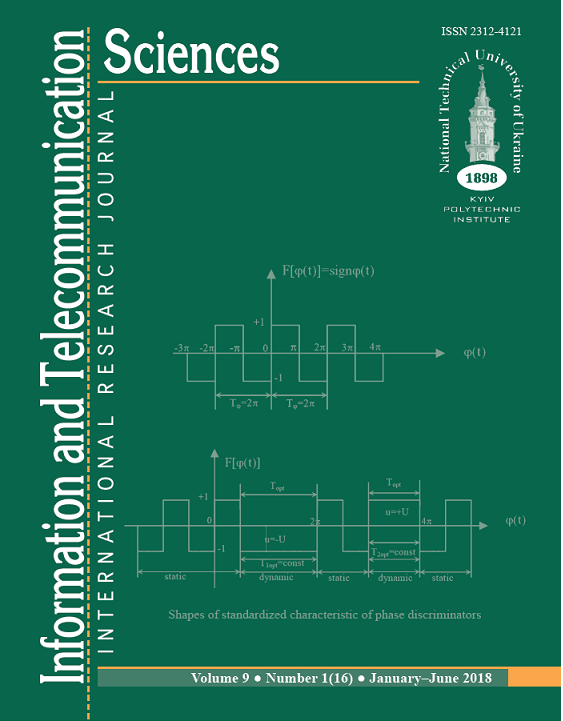FORMATION OF A LOW-FREQUENCY COMPONENT OF AN OPTICAL SIGNAL BY PULSES OF A GAUSSIAN FORM
DOI:
https://doi.org/10.20535/2411-2976.12018.26-33Keywords:
Fourier transform, Gaussian pulse, state of locking mode, convergence, Jon Tikhiy.Abstract
Background. Increasing the spectral efficiency of fiber-optic transmission systems (FOTS) is a topical problem. Currently used single-wave FOTS on the basis of equipment type STM allow the transfer of data at rates up to 40 Gbit/s. Given the available optical bandwidth of approximately from 175 THz till 375 THz, the bandwidth of the possible transmission band is about 200 THz. The value of the spectral efficiency index is about 0.005 bits/Hz. Usage of DWDM systems with widely spaced carriers allows increasing the spectral efficiency approximately an order of magnitude, which in principle does not solve the initial problem. Experimental developments are known in which the transmission rate is reached up to 160 Tbit / s. A special optical fiber with 348 transparency windows is used. The spectral efficiency of such systems reaches unity. The
problem with the widespread use of such systems is the need to replace an already mounted optical cable. For comparison, in industrial mobile communication systems, the spectral efficiency is of the order of 0.5 till 5 bits / Hz.
Objective. Development of theoretical ideas on the formation methods of optical signals with a given structure that allows increasing the bandwidth of FOTS taking into account the dispersion factors and the dependence of the attenuation coefficient on the frequency. These theoretical studies have the ultimate goal of increasing the spectral efficiency of the FOTS using the existing cable infrastructure.
Methods. The formation of a low-frequency component of an optical signal with a given shape under conditions when the basic optical pulses are formed by a pulsed laser in the state of locking mode. In this case, the spectral composition of the optical signal can be formed in such a way as to balance the effects of dispersion and distortion of the spectrum due to the dependence of the damping coefficient on the frequency.
Results. The theoretical substantiation of the principle possibility of approximating processes of a certain form by a sequence of Gaussian pulses is given. Convergence estimates of the corresponding functional series are obtained. The results are valid for narrowband transmission channels with a width of the order of 100 GHz and for the length of the regeneration sections of the order of 100-300 km.
Conclusions. There is a fundamental possibility of short optical signal generation with a given shape using Gaussian impulses. Pulses of approximately Gaussian shape give the laser in the state of locking mode.
Keywords: Fourier transform; Gaussian pulse; state of locking mode; convergence; Jon Tikhiy.
References
Bondarenko O.V. Fiber optic cables / D.V. Iorgachev, O.V. Bondarenko, A.F. Dashenko, A.V. Usov / Odessa: Astroprint, 2000. – 536 p. [in Russian].
Agraval. G. Nonliar fiber optics / Translation from English / Moskow: Mir, 1996. – 323 p. [in Russian].
Odegov N.A. Invariance of the symmetry of optical pulses // ISSN 2219-9365 // Measuring and computing devices in technological processes. №4 (60) / Ukrainian, Khmelnitskiy, 2017. – P. 38 – 43. [in Russian].
Odegov N.A. Method of differentiation of optical signals in the frequency region // International conference №72 of О.S. Popov Odessa national academy of telecommunications, Odessa, Ukraine, 2017. – P. 41 – 44. [in Ukrainian].
Odegov N.A. Dispersion operators and matched optical signals // Scientific journal. Herald of Khmelnytskyi national university, 2017, Issue 5, Volume 253. P. 211 – 220. [in Russian].
Odegov N.A. Transmission of information by optical impulses of equivalent dispersion // ISSN 0131-8675 / Proceeding of the O.S. Popov ONAT. – №2, 2017. – Odessa. – P. 28-38. [in Russian].
Kornejychuk V.I. Optical transmission systems / V.I. Kornejychuk, T.V. Makarov, I.P. Panfilov / Kiev, Ukranian: Technika, 1994. – 388 p.
Makarov T.V. Coherent fiber-optic transmission systems. – Odessa, Ukrainian: O.S. Popov ONAT, 2009. – 220 p. [in Russian].
Broslavets M.A. Features of the generation of ultrashort pulses in a ring YAG: Cr4 + laser in the regime of mode locking / M.A. Broslavets, M.A. Georgieva, A.A. Fomichev // Works of MFTI, Moskow. – 2013. – Vol. 5, No 1. – p. 163– 174. [in Russian].
Yakushin D.A. Femtosecond optics (electronic manual) // D.A. Yakushin, Y.A.. Mal’kov, S.B Bodrov. // Russia, Nizhniy Novgorod: Nizhegorodskiy universitet, 2014. – 40 p. [in Russian].
Prudnikov A.P. Integrals and series / A.P. Prudnikov, Y.A Brychkov, O.I. Marichev. – Moskov: Nauka, 1981. – 780 p. [in Russian].
Stanisław Lem «Starry Diaries of Iyon the Quiet. Journey Fourteenth».
Downloads
Published
How to Cite
Issue
Section
License
The ownership of copyright remains with the Authors.
Authors may use their own material in other publications provided that the Journal is acknowledged as the original place of publication and National Technical University of Ukraine “Igor Sikorsky Kyiv Polytechnic Institute” as the Publisher.
ITS articles are published under Creative Commons licence:
- Authors retain copyright and grant the journal right of first publication with the work simultaneously licensed under CC BY 4.0that allows others to share the work with an acknowledgement of the work's authorship and initial publication in this journal.
- Authors are able to enter into separate, additional contractual arrangements for the non-exclusive distribution of the journal's published version of the work (e.g., post it to an institutional repository or publish it in a book), with an acknowledgement of its initial publication in this journal.
- Authors are permitted and encouraged to post their work online (e.g., in institutional repositories or on their website) prior to and during the submission process, as it can lead to productive exchanges, as well as earlier and greater citation of published work.

